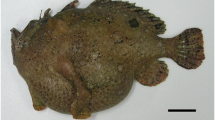Abstract
The so-calledOryzias melastigma (McClelland, 1839), reported from India, Bangladesh, Myanmar, and Malaysia by numerous authors beginning with Day (1877), is based mainly or entirely onAplocheilus panchax (Hamilton, 1822). India and Bangladesh have two species ofOryzias, both large. The deeper-bodied of these two species is reported for the first time asO. dancena (Hamilton, 1822). The other is identified asO. carnaticus (Jerdon, 1849). Myanmar has one large species,O. dancena, and one tiny species,O. uwai new species.Oryzias minutillus Smith, 1945 andO. uwai differ from all otherOryzias in having 4/5 instead of 5/6 principal caudal fin rays.Oryzias uwai differs fromO. minutillus in being more conspicuously pigmented and having large, 6-rayed pelvic fins often extending to anal fin origin instead of much smaller and shorter 5-rayed pelvic fins. In Thailand (including its part of the Mekong basin) three species are known: a large estuarine species tentatively identified asO. javanicus (Bleeker, 1854) and two tiny inland species,O. mekongensis Magtoon & Uwa, 1986, andO. minutillus. Oryzias minutillus from many localities are more or less melanoproctic, i.e. have a darkly pigmented genital or vent area not seen in other species. The Mekong basin in Laos has two large species,O. latipes (Temminck & Schlegel, 1846) andO. pectoralis new species, distinguished by a prominent black blotch on the pectoral fin base, both recently collected in the Nam Theun watershed in central Laos; and two tiny species,O. mekongensis andO. minutillus. Only one species ofOryzias is known from the Mekong delta in Vietnam, the small moderately deep-bodiedO. haugiangensis new species, with 19–22 anal and 9–10 pectoral fin rays. The Indonesian island of Java has one large species,O. javanicus (Bleeker, 1852) with 21–25 anal and 11 pectoral fin rays, and one small species,O. hubbsi new species, with only 17–21 anal and 9 pectoral fin rays.
Similar content being viewed by others
Literature Cited
Ataur Rahman, A. K. 1989. Freshwater fishes of Bangladesh. Zool. Soc. Bangladesh, Dhaka, 364 pp.
Bleeker, P. 1854. Ichthyologische waarnemingen gedaan op verschillende reizen in de residentie Banten. Nat. Tijdschr. Ned. Ind., 7: 309–326.
Bleeker, P. 1860. Ichthyologiae Archipelagi indici prodromi. 2. Cyprini. Lange & Co., Batavia. 492 pp.
Blyth, E. 1858. Report of the Curator, Zoological Department, for May, 1858. J. Asiat. Soc. Bengal. 27: 267–290.
Chen, Y. R., H. Uwa and X. L. Chu. 1989. Taxonomy and distribution of the genusOryzias in Yunnan, China. Acta Taxonom. Sin., 14: 239–246.
Day, F. 1867. On some new or imperfectly known fishes of Madras. Proc. Zool. Soc. London, 1867: 558–565.
Day, F. 1877. The fishes of India; being a natural history of the fishes known to inhabit the seas and freshwaters of India, Burma, and Ceylon. Part 3. Bernard Quaritch, London. 369–552 pp., pls. 79–138.
Hamilton, F. 1822. An account of the fishes found in the river Ganges and its branches. Edinburgh and Scotland. vii+405 pp., atlas, 39 pls.
Hora, S. L. 1929. An aid to the study of Hamilton-Buchanan's “Gangetic Fishes”. Mem. Indian Mus. (Calcutta), 9: 169–192, 11 pls.
Iwamatsu, T., S. Hamaguchi, K. Naruse, K. Takata and H. Uwa. 1993. Stocks ofOryzias species in Japan. The Fish Biology Journal Medaka, 5: 5–10.
Iwamatsu, T., A. Imaki and A. Kawamoto. 1982. OnOryzias javanicus collected at Jakarta and West Kalimantan, Indonesia and Singapore. Annot. Zool. Japan, 55: 190–198.
Jayaram, K. C. 1981. The freshwater fishes of India, Pakistan, Bangladesh, Burma, and Sri Lanka. Zoological Survey of India, Calcutta. xxii+475 pp., 13 pls.
Jerdon, T. C. 1849. On the freshwater fishes of southern India. Part II. Madras, Madras J. Lit. Sci., 15: 302–346.
Jordan, D. S. and J. O. Snyder. 1906. A review of the Poecillidae or killifishes of Japan. Proc. U.S. Natl. Mus., 31: 161–246.
Magtoon, W., N. Nadee, T. Higashitani, K. Takata and H. Uwa. 1992. Karyotype evolution and geographical distribution of the Thai-medaka,Oryzias minutillus, in Thailand. J. Fish Biol., 41: 489–497.
McClelland, J. 1839. Indian Cyprinidae. Asiatic Researches (Calcutta), 19: 217–471, pls. 37–55.
Rainboth, W. J. 1996. Fishes of the Cambodian Mekong. FAO, Rome. xii+265 pp., 27 pls.
Smith, H. M. 1945. The freshwater fishes of Siam, or Thailand. Bull. U.S. Natl. Mus., 188. xi+622 pp., pls. 1–9.
Talwar, P. K. and A. G. Jhingram. 1991. Inland fishes of India and adjacent countries. Oxford & IBH Publishing, New Delhi. 1158 pp. (2 vols.)
Temminck, C. J. and H. Schlegel. 1846. Pisces, part 10–14. Pages 173–269in P.F. de Siebold. Fauna Japonica, sive descriptio animalium quae in itinere per Japoniam suscepto annis 1823–30 collegit, notis observationibus et adumbrationibus illustravit P.F. de Siebold.
Uwa, H. 1986. Karyotype evolution and geographical distribution in the ricefish, genusOryzias (Oryziidae). Pages 867–876in T. Uyeno, R. Arai, T. Taniuchi and K., Matsuura, eds. Indo-Pacific Fish Biology: Proceedings of the Second International Conference on Indo-Pacific Fishes. Ichthyological Society of Japan, Tokyo.
Uwa, H., T. Iwamatsu and O. P. Saxena. 1983. Karyotype and cellular DNA content of the Indian ricefish,Oryzias melastigma. Proc. Japan Acad., 59: 43–47.
Uwa, H. and A. Iwata. 1981. Karyotype and cellular DNA content ofOryzias javanicus (Oryziatidae, Pisces). Chrom. Inf. Serv., 31: 24–26.
Uwa, H. and W. Magtoon. 1986. Description and karyotype of a new ricefish,Oryzias mekongensis, from Thailand. Copeia, 1986: 473–478.
Uwa, H. and L. R. Parenti. 1988. Morphometric and meristic variation in ricefishes, genusOryzias: a comparison with cytogenetic data. Japan. J. Ichthyol., 35: 159–166.
Uwa, H., R.-F. Wang and Y.-R. Chen. 1988. Karyotypes and geographical distribution of ricefishes from Yunnan, southwestern China. Japan. J. Ichthyol., 35: 332–340.
Author information
Authors and Affiliations
About this article
Cite this article
Roberts, T.R. Systematic observations on tropical Asian medakas or ricefishes of the genusOryzias, with descriptions of four new species. Ichthyological Research 45, 213–224 (1998). https://doi.org/10.1007/BF02673919
Received:
Revised:
Accepted:
Issue Date:
DOI: https://doi.org/10.1007/BF02673919




